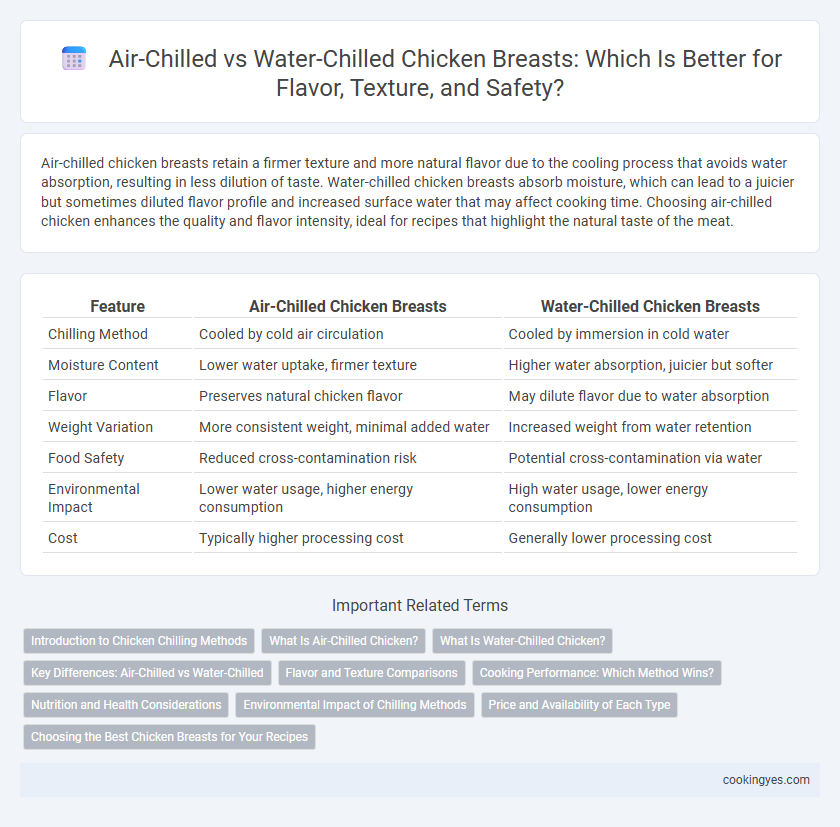Air-chilled chicken breasts retain a firmer texture and more natural flavor due to the cooling process that avoids water absorption, resulting in less dilution of taste. Water-chilled chicken breasts absorb moisture, which can lead to a juicier but sometimes diluted flavor profile and increased surface water that may affect cooking time. Choosing air-chilled chicken enhances the quality and flavor intensity, ideal for recipes that highlight the natural taste of the meat.
Table of Comparison
| Feature | Air-Chilled Chicken Breasts | Water-Chilled Chicken Breasts |
|---|---|---|
| Chilling Method | Cooled by cold air circulation | Cooled by immersion in cold water |
| Moisture Content | Lower water uptake, firmer texture | Higher water absorption, juicier but softer |
| Flavor | Preserves natural chicken flavor | May dilute flavor due to water absorption |
| Weight Variation | More consistent weight, minimal added water | Increased weight from water retention |
| Food Safety | Reduced cross-contamination risk | Potential cross-contamination via water |
| Environmental Impact | Lower water usage, higher energy consumption | High water usage, lower energy consumption |
| Cost | Typically higher processing cost | Generally lower processing cost |
Introduction to Chicken Chilling Methods
Air-chilled chicken breasts undergo a cooling process involving cold air circulation, preserving natural flavor and reducing water retention, whereas water-chilled chicken breasts are submerged in cold water baths to rapidly lower their temperature, which can increase moisture content but may dilute flavor. Air-chilling enhances texture and minimizes cross-contamination risks by avoiding shared water tanks, while water-chilling is favored for its faster processing time and lower cost. Understanding these chilling methods is crucial for assessing quality, taste, and food safety in chicken breast preparation.
What Is Air-Chilled Chicken?
Air-chilled chicken breasts are processed by being cooled with cold air instead of water, reducing moisture absorption and enhancing natural flavor and texture. This method helps maintain a firmer, less watery product, often preferred by chefs and consumers seeking higher quality poultry. Air-chilling also minimizes cross-contamination risks and can result in a longer shelf life compared to traditional water-chilled chicken breasts.
What Is Water-Chilled Chicken?
Water-chilled chicken breasts are rapidly cooled by immersion in cold water shortly after slaughter, which helps reduce the internal temperature and limits bacterial growth. This method increases water absorption, often adding up to 4-6% additional weight, which can affect cooking yield and texture. Although water chilling is efficient and cost-effective, it may result in slightly less firm meat compared to air-chilled chicken.
Key Differences: Air-Chilled vs Water-Chilled
Air-chilled chicken breasts are cooled by circulating cold air around the meat, resulting in a firmer texture and more concentrated flavor due to reduced water absorption. Water-chilled chicken breasts are submerged in cold water, which increases moisture content but can dilute flavor and create a slightly softer texture. The choice between air-chilled and water-chilled impacts both taste quality and cooking performance, with air-chilled often preferred for premium freshness and texture.
Flavor and Texture Comparisons
Air-chilled chicken breasts retain a firmer texture and more pronounced, natural flavor due to reduced water absorption during processing, enhancing juiciness and cooking performance. Water-chilled chicken breasts often absorb more moisture, resulting in a slightly softer texture but potentially diluted flavor, which can impact seasoning absorption. Consumer preference leans toward air-chilled for a richer taste and improved mouthfeel in cooked dishes.
Cooking Performance: Which Method Wins?
Air-chilled chicken breasts retain firmer texture and enhanced flavor due to minimal water absorption, resulting in better searing and juiciness during cooking. Water-chilled chicken absorbs more moisture, which can lead to a less crispy exterior and diluted flavor profiles when grilled or pan-fried. Chefs and food scientists often favor air-chilled chicken for superior cooking performance and consistent results.
Nutrition and Health Considerations
Air-chilled chicken breasts retain more natural moisture and nutrients due to the absence of water immersion, resulting in a higher protein concentration and less water weight compared to water-chilled chicken. Water-chilled chicken may absorb small amounts of water, potentially diluting nutrient density and increasing bacterial contamination risks if not properly handled. Choosing air-chilled chicken supports better texture, reduced sodium exposure, and minimizes the likelihood of cross-contamination, promoting improved overall food safety and nutritional value.
Environmental Impact of Chilling Methods
Air-chilled chicken breasts require less water consumption compared to water-chilled methods, significantly reducing freshwater usage in processing plants. The air-chilling process minimizes wastewater generation, lowering the risk of water pollution from contaminants like blood and bacteria. Choosing air-chilled chicken supports more sustainable poultry production by decreasing environmental strain related to water resources and waste management.
Price and Availability of Each Type
Air-chilled chicken breasts typically cost more than water-chilled options due to higher processing expenses and slower production times, making them less widely available in mainstream grocery stores. Water-chilled chicken breasts are more common and generally priced lower because of faster, large-scale processing methods used by most poultry suppliers. Consumers seeking air-chilled chicken often find better availability at specialty markets and health-focused retailers, where price premiums reflect the perceived quality and flavor benefits.
Choosing the Best Chicken Breasts for Your Recipes
Air-chilled chicken breasts retain a firmer texture and richer flavor because they are cooled by cold air rather than water, preventing water absorption that can dilute taste. Water-chilled chicken breasts tend to weigh more due to water retention, which may affect cooking times and the overall flavor profile. Selecting air-chilled chicken is ideal for recipes demanding a more natural, robust chicken flavor and a consistent, tender texture.
Air-Chilled vs Water-Chilled for Chicken Breasts Infographic

 cookingyes.com
cookingyes.com